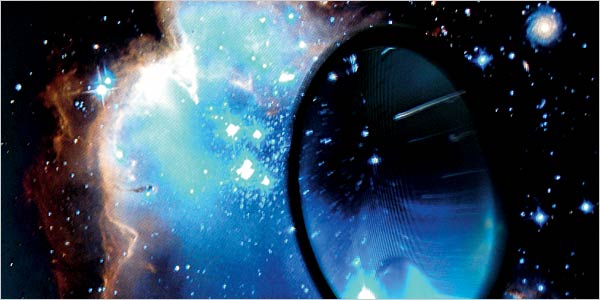New research points to the potential resiliency of life around active red dwarf stars.



Bizarre it is.
Some truths about the Universe and our experience in it seem immutable. The sky is up. Gravity sucks. Nothing can travel faster than light. Multicellular life needs oxygen to live. Except we might need to rethink that last one.
Scientists have just discovered that a jellyfish-like parasite doesn’t have a mitochondrial genome — the first multicellular organism known to have this absence. That means it doesn’t breathe; in fact, it lives its life completely free of oxygen dependency.
This discovery isn’t just changing our understanding of how life can work here on Earth — it could also have implications for the search for extraterrestrial life.

Emerging technologies and new strategies are opening a revitalized era in the Search for Extraterrestrial Intelligence (SETI). New discovery capabilities, along with the rapidly-expanding number of known planets orbiting stars other than the Sun, are spurring innovative approaches by both government and private organizations, according to a panel of experts speaking at a meeting of the American Association for the Advancement of Science (AAAS) in Seattle, Washington.
New approaches will not only expand upon but also go beyond the traditional SETI technique of searching for intelligently-generated radio signals, first pioneered by Frank Drake’s Project Ozma in 1960. Scientists now are designing state-of-the-art techniques to detect a variety of signatures that can indicate the possibility of extraterrestrial technologies. Such “technosignatures” can range from the chemical composition of a planet’s atmosphere, to laser emissions, to structures orbiting other stars, among others.
The National Radio Astronomy Observatory (NRAO) and the privately-funded SETI Institute announced an agreement to collaborate on new systems to add SETI capabilities to radio telescopes operated by NRAO. The first project will develop a system to piggyback on the National Science Foundation’s Karl G. Jansky Very Large Array (VLA) that will provide data to a state-of-the-art technosignature search system.

“The discovery of dark energy has greatly changed how we think about the laws of nature,” said Edward Witten, creator of string theory and one of the world’s leading theoretical physicist at the Institute for Advanced Study in Princeton, N.J. who has been compared to Newton and Einstein.
One of the great known unknowns of the universe is the nature of dark energy, a force field making the universe expand faster. Current theories range from end-of-the universe scenarios to dark energy as the manifestation of advanced alien life.
A new, controversial theory suggests that this dark energy might be getting stronger and denser, leading to a future in which atoms are torn asunder and time ends.

This approach can be described as “physical eschatology” – a term coined by the astronomer Martin Rees for using astrophysics to model where the Universe is going. Rees took a cue from theology, in which “eschatology” is the study of ultimate things such as the end of the world. And the classic paper on the topic is Freeman Dyson’s 1979 paper on life in open universes, which outlined likely or possible existential catastrophes that could threaten life far into the future, from the death of the Sun to the detachment of stars from galaxies.
How long can civilisation survive? To thrive for billions of years, there will be a few troublesome problems to solve – from the death of the Sun to the decay of matter.
If aliens are real, where are they?
Complex cognitive dissonance disorder guaranteed. 😬.
Garrett Lisi, the so called “Surf Bum with a Theory of Everything (or T.O.E.)”, is a PhD theoretical physicist who has refused to be captured by the theoretical physics community. By making shrewd investments, he has avoided holding meaningful employment for his entire adult life. Instead, he lives in Maui and travels the world chasing the perfect wave.
In this episode Garrett and Eric sit down to discuss the current status of Garrett’s ideas for a final theory based on a mysterious object called E8, perhaps the oddest of mathematical symmetries to be found in the universe. Garrett and Eric have held each other in mutual “contempt” for over a decade. By vacationing together and staying in each others’ homes, they had hoped to hone and deepen their mutual disgust for each other’s ideas. However, as the theoretical physics community moved away from actually trying to unify our incompatible models of the physical world, it became intellectually unmoored, and drifted toward a culture of performative Cargo Cult Physics. The antagonists were thus forced by necessity to develop a begrudging admiration for each other’s iconoclasm and unwillingness to give up on the original dream of Einstein to unify and understand our world.
The discussion is rough but a fairly accurate depiction of scientific relationships belonging to a type that is generally not shown to the public. This may be uncomfortable for those who have been habituated to NOVA, The Elegant Universe, or other shows produced for mass consumption. We apologize in advance.
Original sponsors of the audio version of the episode:


Circa 2017(article) essentially higgs mode could help be a developer mode for creating life or universes really anything creating unparalleled technology even invulnerable metals or nearly impossible properties.
In this book, Merali explores the possibilities of creating an infant universe in a laboratory. Read on.

Many philosophers and scientists believe that we need an explanation as to why the laws of physics and the initial conditions of the universe are fine-tuned for life. The standard two options are: theism and the multiverse hypothesis. Both of these theories are extravagant and arguably have false predictions. Drawing on contemporary philosophy of mind, I outline a form of panpsychism that I believe offers a more parsimonious and less problematic explanation of cosmological fine-tuning.